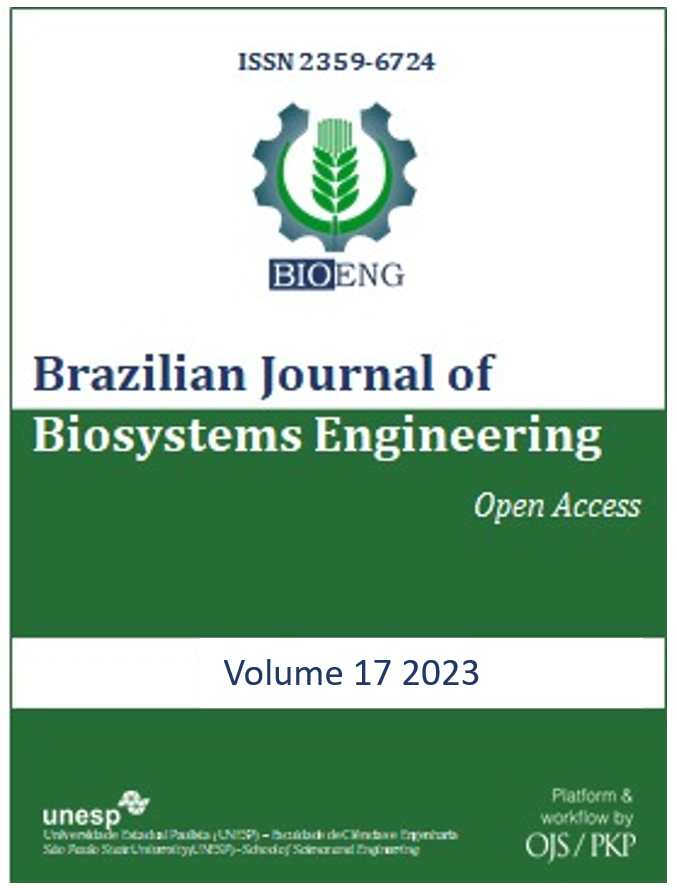Distance of brachiaria management in between the rows of coffee trees
DOI:
https://doi.org/10.18011/bioeng.2023.v17.1184Palavras-chave:
Biomass, Coffea arabica, soil covering, soil protection and improvement, ProductivityResumo
Brazil is the world's largest coffee producer, but with the changes in climate that have occurred in recent years, the concern with soil management with cover crops has become important, since it configures a strategy that can contribute to the improvement of production systems. Brachiaria is one of the main species used in intercropping in coffee production to generate biomass and soil cover. The objective of this research was to evaluate the effect of the distance of brachiaria management in between rows of coffee trees. The research was carried out from 2016 to 2022 in a coffee plantation implanted in 2016 with the cultivar Catuai Amarelo IAC 62 associated with Brachiaria ruziziensis, in a randomized block design, with 6 treatments and 4 replications: T1- without brachiaria between the rows (control), T2 - management of brachiaria up to the projection of the coffee tree crown, T3 - management with 25 cm distance from the projection of the crown of the coffee tree, T4 - management with 50 cm away from the projection of the coffee tree crown, T5 - management with 75 cm distance from the projection of the coffee tree crown, T6 - management with 100 cm distance from the projection of the coffee tree crown. The evaluated parameters were: setting and establishment of coffee seedlings, height of the orthotropic branches, length of the plagiotropic branches, number of internodes, and productivity. The intercropping of the coffee tree with brachiaria must be managed at 50 cm from the projection of the plagiotropic branch of the coffee tree, aiming at non-competition and better development of the crop.Downloads
Referências
Alcântara, E. N.; Ferreira, M. M. (2009). Efeito de métodos de controle de plantas daninhas na produção de café durante 30 anos. In: SIMPÓSIO DE PESQUISA DOS CAFÉS DO BRASIL, 6, Vitória. Anais. Brasília, DF: Embrapa Café, 2009. 1 CDROM.
Bogdan, A.V. (1977). Tropical pasture and fodder plants. New York :Longman, 475p.
Calegari, A. Plantas de cobertura. Manual Técnico. Fev. 2016. Penergetic. Uberaba, MG 24p. (3a. edição).
Calegari, A. Cover crops. In “Penergetic the natural Biotechnology. With the impulse of Nature. For intelligent Agriculture”. (2018a). Publisher: Penergetic International AG. Romiszelgstrasse. CH- 8590 Romanshorn. www.penergetic.com Graphic Design, Silvia Wasner. Switzerland. P. 07- 33.
Calegari, A. Advantages in coffee planting when using cover crops and penergetic products. In “Penergetic the natural Biotechnology. With the impulse of Nature. For intelligent Agriculture”. (2018b). Publisher: Penergetic International AG. Romiszelgstrasse. CH- 8590 Romanshorn. www.penergetic.com Graphic Design, Silvia Wasner. Switzerland. P. 07- 33.
Carvalho, L. B.; Alves, P. L. C. A.; Bianco, S. (2013). Sourgrass densities affecting the initial growth and macronutrient content of coffee plants. Planta Daninha, Viçosa, 31(1), 109-115. DOI: https://doi.org/10.1590/S0100-83582013000100012
Cavalcante, V.S.; Santos, V.R.; Santos Neto, A.L.; Santos, M.A.L.; Santos, C.G.; Costa, L.C. (2012). Biomassa e extração de nutrientes por plantas de cobertura. Revista Brasileira de Engenharia Agrícola e Ambiental, 16(5): 521-528. Doi: https://doi.org/10.1590/S1415-43662012000500008 DOI: https://doi.org/10.1590/S1415-43662012000500008
Coffee and climate, Use of Brachiaria ruziziensis and Cajanus cajan as cover crops for coffee plantations Cofffe plaza, Hamburg Germania, 2019 pg 1-15 Acesso em 13/10/2022 disponível em https://toolbox.coffeeandclimate.org/wp-content/uploads/Case-Study-Brachiaria-as-Temporary-Shade-Trifinio.pdf
Ferreira, D. F. (2014). Sisvar: um guia dos seus procedimentos de comparações múltiplas Bootstrap. Ciência e Agrotecnologia, 38(2), 109-112. DOI: https://doi.org/10.1590/S1413-70542014000200001
Franco Junior et al. (2022). Coverage plants in the management of skeletal coffee. Revista Ceres, 69(3), 247-255. DOI: https://doi.org/10.1590/0034-737x202269030001
Franco Junior et al. (2018) Effect of cover crops and bioactivators in coffee production and chemical properties of soil. Coffee Science, Lavras, 13(4), 559-567. DOI: https://doi.org/10.25186/cs.v13i4.1516
Matiello, J.B.; Santinato, R.; Garcia, A.W.R.; Almeida, S.R.; Fernandes, D.R. (2010). Cultura de Café no Brasil, Manual de Recomendações. Varginha, Procafé. 542p.
Matiello, J.B.; Santinato, R.; Garcia, A.W.R.; Almeida, S.R.; Fernandes, D.R. (2020). Cultura de Café no Brasil, Manual de Recomendações. Varginha, Procafé. 716p.
Matiello, J.B.; Lacerda, G. (2017). Efeito de sistemas de condução do mato, na entrelinha inicial de cafeeiros, no Sul de Minas. Embrapa Café. 1 (1). 1-2p.
Ragassi, C.F.; Pedrosa, A. W.; Favarin, J. L. (2013). Aspectos positivos e riscos no consórcio cafeeiro e braquiária. Visão Agrícola, 12(1), 29-32.
Disponível em:<https://www.esalq.usp.br/visaoagricola/sites/default/files/va12-instalacao-da-lavou
ra05.pdf>. Acesso em 16 de Nov. 2021.
Ronchi, C.P. (2002). Interferência e controle de plantas daninhas na cultura de café (Coffea arabica L.), 115 f. Dissertação (Mestrado em Fitotecnia) Universidade Federal de Viçosa, Viçosa.
Santos, J.C.F.; Costa, R.S.C.; Leônidas, F.C.; Mendes, A.M.; Rodrigues, V.G.S. (2014). Manejo agroecológico de plantas daninhas da cultura do café. Porto Velho, RO: EMBRAPA, Documentos 159, 28p.
Souza, L.S.; Losasso, P.H.L.; Oshilwa, M.; Garcia, R.R.; Goes Filho, L.A. (2006). Effect of Brachiaria decumbens control bands on the initial development and productivity of Coffea arábica. Planta Daninha, 24(4), 715-720. DOI: https://doi.org/10.1590/S0100-83582006000400012
Downloads
Publicado
Como Citar
Edição
Seção
Licença
Copyright (c) 2023 Revista Brasileira de Engenharia de Biossistemas

Este trabalho está licenciado sob uma licença Creative Commons Attribution 4.0 International License.
Autores que publicam nesta revista concordam com os seguintes termos:
a) Autores mantém os direitos autorais e concedem à revista o direito de primeira publicação, com o trabalho simultaneamente licenciado sob a Licença Creative Commons Attribution que permite o compartilhamento do trabalho com reconhecimento da autoria e publicação inicial nesta revista.
b) Autores têm autorização para assumir contratos adicionais separadamente, para distribuição não-exclusiva da versão do trabalho publicada nesta revista (ex.: publicar em repositório institucional ou como capítulo de livro), com reconhecimento de autoria e publicação inicial nesta revista.








